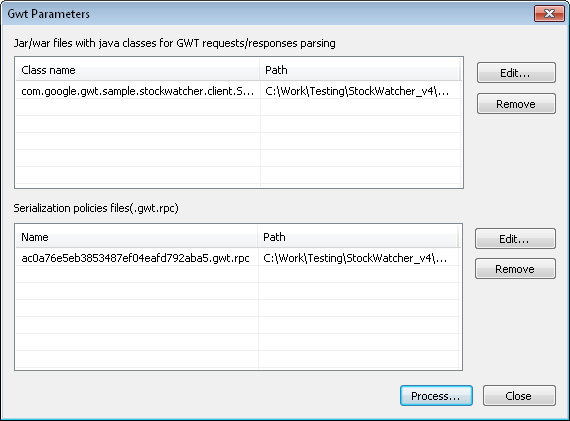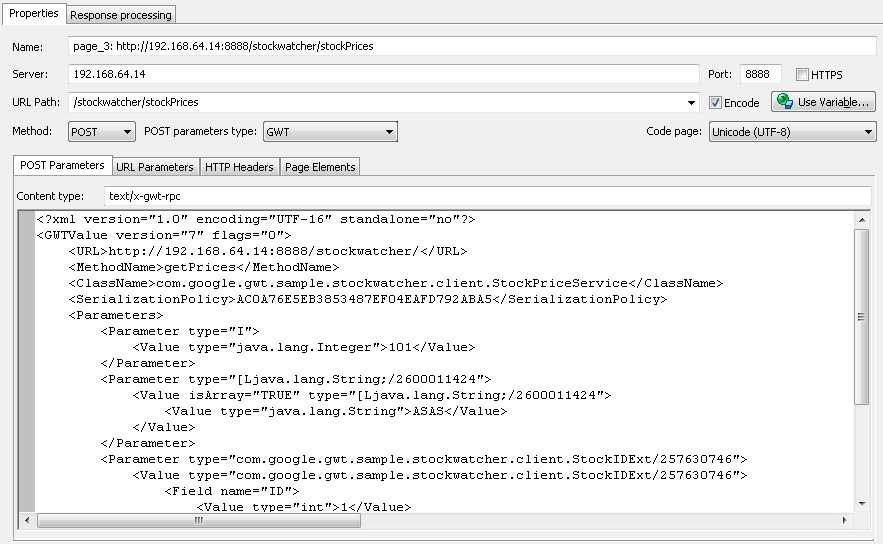We have recently released a new extension module for WAPT and WAPT Pro products. As its name suggests, it is targeted at handling web applications developed with help of GWT (Google Web Toolkit).
Till now we have had 4 extension modules. Two of them are optional (ASP.net and JSON), meaning that you can use them to facilitate testing (in many cases this means a significant improvement), but still there are no applications for which these modules are mandatory.
Two other modules (Flash and Silverlight) are used to convert binary data to XML and back again. So, if you have an application developed in Flash or Silverlight, you will not be able to load test it properly without the corresponding module.
The new GWT module stays somewhere in the middle in this classification. It converts to XML complex data structures contained inside requests and responses, but in this case the data is originally represented in text format, so in general it is possible to parameterize everything without such conversion. However, in complex cases this will require a lot of efforts without the module and just few steps with help of it.
The client part of a GWT application is often implemented in such a way that it can send remote procedure calls (RPC) to the server part. Such calls are passed inside special HTTP requests containing serialized data structures that are used as function arguments. The server replies with the function return value which can also be a complex data structure. This reply is provided in the corresponding HTTP response.
The Module for GWT Testing lets you import the jar/war files of your GWT project containing application .class files and .gwt.rpc files containing serialization policy in order to enable conversion of serialized data to XML.

So, after installing and configuring the module on top of WAPT or WAPT Pro, you will see the XML documents inside the bodies of all GWT requests and responses.
Here is an example showing the content of a GWT-request before applying the module.

The same request body is converted by the module to the following XML.

The same way you can convert any response and extract any values from it with help of the standard XPath() function. The extracted values can be used in subsequent requests for parameterization. On the test execution the module will convert the parameterized XML back to GWT structures expected by your server to ensure the correct emulation.
Good news for those customers who use our products regularly to load test different web applications. If you have already purchased the Module Pack (containing all 4 previously existing modules), we provide the GWT module license to you free of charge.
You may also notice that even though the regular price for the new module is $350, its addition has not increased the price of the Module Pack. So, you can now save much more by ordering all modules at once.

Hi,
1.Recorded the GWT application using proxy with firefox.
2.Script recorded successfully.
3.Able to “Verify Test” successfully.
4.Conigured the Java.exe in Settings, mapped the Required .Jar files and .RPC files in GWT Parameters.
5.When click “Process” button, throws “Can’t load jvm.dll.Set path to java.exe in Settings\GWT dialog”. error. but java is configured already..
Can you please help me on this..
tx
ravi
Hello Ravi,
What version of Java do you use and what is your OS? Please let me know.
Normally, the folder where the java.exe is located contains sub-folder named “client”. That sub-folder contains the jvm.dll file. Please check if it is present on your system.
Regards,
Ivan
Hi Ivan,
I am getting the same error and i configured everything properly.
Rahul
Hello Rahul,
Please send the details to support@loadtestingtool.com.
Regards,
Ivan
Hi Ivan,
We have a scenario where we would like to execute a “Java CLASS” file that executes a static method. The static method is a test harness that performs a set of client side operations and then makes a http server call as a last step.
For example there are 5 steps in the static method. Step 1 till Step 4 is the client side process and Step 5 is a http request to a server for which we get a response and the object is written to a file on the client side. Simply executing the last step does not help our cause as information is dynamically generated in step 1 till 4.
Kindly advise how can we execute the above scenario and how can this be configured in WAPT Pro 3.1?
Regards
Debasis